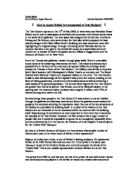Persuasive Essay
Nathan McLennan, 5 Kintyre B
The Turner Prize
Recently, considerable media attention has again been given to the critically acclaimed Turner Prize and its entries.
The Turner Prize is awarded to a British artist who is under 50 years old for an outstanding presentation or exhibition of their work in the twelve months preceding the judgement date (usually in May). The Prize was established by Tate's Patrons of New Art in 1984. The Turner Prize is widely recognised as one of the most important and prestigious awards for the visual arts in Europe.
There are no surprises that a work of classical media (i.e. paint) failed to clinch the elusive prize, but paintings are rarely seen, or even short-listed. A few years ago, however, Chris Ofili’s unusual portrayal of the mother of Christ done in acrylic, oils, glitter and elephant dung took first place - the closest thing to a traditional painting for a long time. Chris Ofili is renowned for his alternative approach to art. He is acclaimed in the art world, even though he uses elephant dung in his work - a passing nod to his roots in Zimbabwe and British Colonialism – and the generally offensive nature of his work. In fact, the mayor of New York threatened to cut the grant for the Manhattan museum of modern art unless the show which contained Ofili’s work was cancelled. He specifically singled out some work, Ofili’s among it, as ‘sick stuff.’







